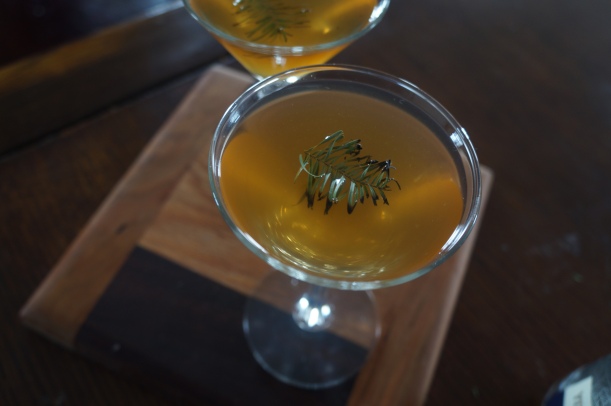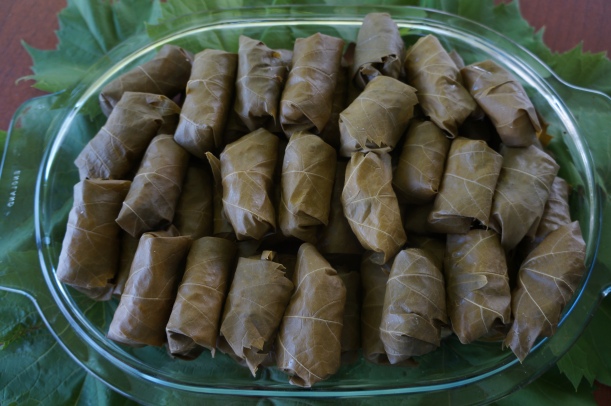 When I read today’s Fiesta Friday post, one recipe featured from last week particularly caught my eye and I decided to make it right away. Unwilling to go shopping I had to make do with either what I had in my own kitchen or garden, and by the time I finished I had used in my version, still recognizable as Monika’s, a few ‘new’ ingredients I thought worth sharing.
When I read today’s Fiesta Friday post, one recipe featured from last week particularly caught my eye and I decided to make it right away. Unwilling to go shopping I had to make do with either what I had in my own kitchen or garden, and by the time I finished I had used in my version, still recognizable as Monika’s, a few ‘new’ ingredients I thought worth sharing.
The recipe I refer to is one for Pomegranate Beet Salsa by Monika at Everyday Healthy Recipes. It is the perfect dish for these hot dry days- simple to prepare, keeps well, and as good on its own as it is a side dish. Thank you Monika!
The so-called new ingredients in my recipe are red currants (ribes rubrum) and Queen Anne’s lace (daucus carota) leaves. The currants I have used before to make salad dressing and mayonnaise, but I had never thought of putting them whole into a salad. They are found in much of North Eastern US and Eastern Canada. Once established they thrive in sunny spots, and apparently are drought resistant given that they are still thriving in our back yard desert. One source I read describes them as a brilliant red skin encasing a pulpy flesh that contains 3-12 tiny edible seeds with flavours of raspberry, cranberry, gooseberry, rhubarb and a hint of rose. That sounds about right to me. Many sources say they are delicious as long as you add lots of sugar, which explains why they are most often used to make jelly. However, used sparingly in a savoury dish such as this one, no sugar is needed.
As for the Queen Anne’s lace, there is so much of it blooming right now, but I had not given any thought to anything other than the flowers. I know that all parts of the plant are edible and often see reference to the leaves as being good in salads, but have never seen a salad recipe that calls for them. For identification and further information on this plant, please check here.
Again, the herbs I used are all from my garden, but this salad is versatile, and you can make your own mix of greens to add. As for the oil, I used my black walnut infused oil, and I think any nut oil would be good, or just a good quality oil as Monika suggests, such as grape seed oil.
Beet and Red Currant Salad
3 Tbsp finely chopped red onion
3 Tbsp balsamic vinegar
2 cups chopped beets, previously boiled, cooled and peeled
2 Tbsp chopped Queen Anne’s lace leaves
1 heaping Tbsp each of fresh mint and dill
2 Tbsp oil
salt and pepper to taste
3/4 cup red currants
Put the onion and vinegar in a bowl and allow to sit while preparing the other ingredients. Add everything except the currants and mix well. Gently fold in the currants. Refrigerate for at least an hour before serving for best flavour.
 Linked to: Fiesta Friday #233
Linked to: Fiesta Friday #233

 Some time ago I wrote about using black walnuts, and at that time I promised some recipes, but nothing happened. I’m not sure what I did with that first batch, but as I received another gift of fresh local nuts (thank you David) I have been giving a lot of thought to how to use them. Because they are either expensive to buy or labour intensive to harvest, I was thinking of recipes where a little would go a long way. Infusions seemed a good idea because if you have trouble separating the nut from the shell and you accidentally a few bits of shell get past you, you won’t have to worry about cracking your teeth. You can read about characteristics, identification, harvesting and shelling in my first
Some time ago I wrote about using black walnuts, and at that time I promised some recipes, but nothing happened. I’m not sure what I did with that first batch, but as I received another gift of fresh local nuts (thank you David) I have been giving a lot of thought to how to use them. Because they are either expensive to buy or labour intensive to harvest, I was thinking of recipes where a little would go a long way. Infusions seemed a good idea because if you have trouble separating the nut from the shell and you accidentally a few bits of shell get past you, you won’t have to worry about cracking your teeth. You can read about characteristics, identification, harvesting and shelling in my first 







 I first wrote about prickly ash (zanthoxylum americanum) aka Szechwan pepper last year in
I first wrote about prickly ash (zanthoxylum americanum) aka Szechwan pepper last year in 
 I dried them on the countertop and within a day or so the husks turned from deep red to brown and the shiny black berries were exposed.
I dried them on the countertop and within a day or so the husks turned from deep red to brown and the shiny black berries were exposed. Now they are ready to be stored and used in so many ways. So far I have made spice mixtures, added them to
Now they are ready to be stored and used in so many ways. So far I have made spice mixtures, added them to 
 Three things to note about cooking with these leaves are:
Three things to note about cooking with these leaves are:
 Queen Anne’s Lace (daucus carota), also known as wild carrot, bird’s nest and bishop’s lace is a white flowering plant in the familily Apiaceae. Its feathery leaves are similar to those of hemlock, fool’s parsley and water hemlock, all poisonous cousins, so it is important to identify this plant correctly. At this time of year when they are in full bloom it is easy to spot with its flat-topped white umbel, sometimes with a solitary purple flower in the centre.
Queen Anne’s Lace (daucus carota), also known as wild carrot, bird’s nest and bishop’s lace is a white flowering plant in the familily Apiaceae. Its feathery leaves are similar to those of hemlock, fool’s parsley and water hemlock, all poisonous cousins, so it is important to identify this plant correctly. At this time of year when they are in full bloom it is easy to spot with its flat-topped white umbel, sometimes with a solitary purple flower in the centre.

 Linked to:
Linked to: 











 Linked to
Linked to